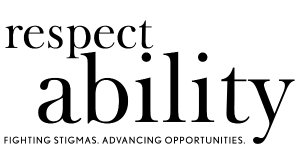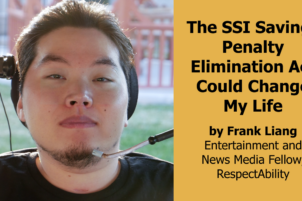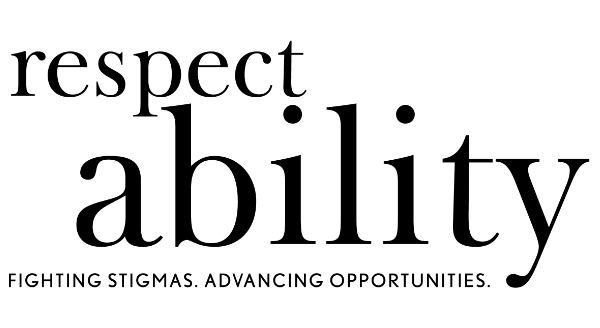RespectAbility Submits Comments to the Social Security Administration in Response to Request for Information on Strategies to Improve Adult Outcomes for Youth Receiving Supplemental Security Income (SSI)
Rockville, Md., Jan. 26 – RespectAbility, a nonprofit organization fighting stigmas and advancing opportunities for people with disabilities, submitted the following comments to the Social Security Administration in response to their Request for Information (RFI) to elicit ideas, strategies, and best practices related to improving adult economic outcomes for youth aged 14 to 25 with disabilities receiving Supplemental Security Income (SSI). We are a national, non-partisan, nonprofit organization fighting stigmas and advancing opportunities for and with people with disabilities. We advocate for the 1-in-5 Americans who have a physical, intellectual, sensory, learning, attention, mental health or other disability. This includes 6 million students with diagnosed disabilities who are enrolled in America’s public schools. We invited SSA to sustain its commitment to improving outcomes for youth with disabilities by considering the range of best practices that are achieving transformative results.
Question 1) What specific programs or practices have shown promise at the Federal, State, or local level in improving the adult economic outcomes of youth with disabilities receiving SSI? What specific programs or practices have shown promise at the Federal, State, or local level in improving the adult economic outcomes of youth with disabilities receiving SSI?
First and foremost, we wish to raise the opportunities that apprenticeship programs offer. Anyone who works hard should be able to get ahead in life. Students with disabilities deserve the opportunity to earn an income and achieve independence, just like anyone else. For those youth with disabilities, RespectAbility believes that apprenticeships are critical.
Apprenticeship has rapidly become a key priority in workforce development. Nationally, there already are two models that are achieving extraordinary success with work based learning opportunities: Project SEARCH and Bridges from School to Work. SEARCH is a unique, employer driven transition program that prepares students with disabilities for employment success. Likewise, the Bridges program offers assessments, workshops and job matching. This model has grown to more than 300 programs in 46 states and served nearly 3,000 youth in 2015. Among those young people, more than 78 percent found jobs. These are transformative results for a population that faces serious barriers to pursuing life and liberty. These results also show how a focused commitment to school-to-work transitions can create brighter futures for students with disabilities.
In terms state level work, there are critical lessons to be learn and we wish raise those lessons with SSA. According to last years’ Annual Disability Statistics Compendium, only 34.9 percent of U.S. civilians with disabilities ages 18-64 living in the community nationally had a job in 2015, compared to 76.0 percent for people without disabilities. Out of almost 20 million working age people with disabilities, only 7.1 million people with disabilities have a job. Millions who would rather be working are living on government benefits instead.
However, looking at national statistics only tells part of the story facing millions of job seekers with disabilities who want to become independent and earn an income. Digging into the data compiled by the Rehabilitation Research and Training Center on Disability Statistics and Demographics (StatsRRTC) shows serious differences in employment outcomes at the state level. In fact, there are some states where people with disabilities are twice as likely to be employed as in other states.
Wyoming leads the nation with 57.1 percent of their citizens with disabilities employed. Wyoming is followed by the Dakotas where 51.7 percent of South Dakotans with disabilities have a job and 48.6 percent of North Dakotans with disabilities are employed. Other top 10 states include Nebraska with a 48.6 employment rate for people with disabilities, Minnesota (47.5), Iowa (46.3), Utah (45.8), Kansas (42.8), Alaska (42.6) and Wisconsin (41.2). We track trends in state level employment, policy and practice on an annual basis and invite you to read our detailed report on that topic. http://bit.ly/2xbsNL4
A critical challenge that looms large for youth with disabilities is the critical need to promote competitive, integrated, meaningful employment at minimum wage and above. Although the paradigm is shifting dramatically, many people with disabilities remain trapped in subminimum wage work, usually in sheltered workshops, which leads to perpetual economic poverty. Focusing on integrated, meaningful employment will help YWD join a more competitive integrated workforce, which is ideal. The National Council on Disability has looked closely and critically at the issue of subminimum wages and has valuable insights and recommendations to offer. Their most recent report on the issue recommended gradual phasing out Section 14(c) of the Federal Labor Standards Act of 1938 and adopting a competitive integrated work model. The programs that have the most promise are those that empower transitioning young adults to discover their strengths and skills, and allows them to use self-determination to choose where to work. Thus, why we point to the value and transformative successes of models such as Project SEARCH.
Beyond successful states such as Wyoming and the Dakota, Vermont embodies the gradual phase-out process that the National Council on Disability recommends for 14(c) certificates. A fully supported work model was in planning and implementation since the 1980s. In 2000, Vermont stopped funding sheltered workshops and by 2003, all sheltered workshops were closed. In place, Vermont opened supported employment agencies in every county as part of Developmental Disabilities Service Division.
Supported work models also allow youth with disabilities better economic outcomes and faster. Youth with disabilities can succeed when given the tools to become competitive employees off the bat. A study from 2011 looked at the economic outcomes of people with Autism Spectrum Disorder. Half of those studied had been in sheltered workshops and transitioned to competitive employment, and the other half had transitioned to competitive employment out of school. Those who had been in a sheltered workshop still earned significantly less than their counterparts who had not. That same study determined that those who had been in sheltered workshops were more likely to receive more government aid than their counterparts who had not participated. Work-based learning – identifying students’ skills in employment settings and highlighting these in their individual education program (IEP) have been proven effective in transitions.
Question 2) Given the requirement of VR agencies to serve transition-age individuals, the availability of Individualized Education Programs (IEP) and Section 504 plans in school settings, and the availability of services and supports elsewhere available to youths, what should SSA’s role be in assisting the transition of youths to adulthood?
The National Council on Disability recently conducted a detailed review of trends in vocational rehabilitation and the specific issue of Preemployment Transition Services (PETS). As suggested by the NCD in their review, one of the difficulties VR agencies have is that they cannot provide services to those who are not determined eligible. This means that students have to go through the eligibility process, which can take up to 90 days. If disabled students, who under WIOA should be receiving some sort of transition service, are just looking into the process at the end of their secondary school career, then they will miss potentially the entire summer’s worth of internship and entry level job opportunities. While the Rehabilitative Services Association (RSA) serves those with disabilities regardless of SSI status, there are many individuals that begin working with their local Vocational Rehabilitation while on SSI.
Those on SSI are much more likely to be employed when they leave the program if they have been through VR services, so a possible solution is to make SSI student recipients aware of VR services in time to take full advantage of them; and also actively helping them to begin the process by connecting them to the correct office/officials.
IEP and 504 plans vary by state, but many are only required to lay out a long-term goal with a practical plan and not provide actual assistance at each step. That is often left up to each VR agency. For those students receiving SSI it is critical again that they actually take that next step into VR services. Unless their plan includes the provision of employment, the IEP/504 is not enough. Many students are overwhelmed by planning so far into the future.
Finally, VR agencies do have a budget for Pre-Employment Transition Services (PETS) planning and active implementation. But the budget is very restricted, especially for “potentially eligible students” (not VR clients) and for those entire agencies under the Order of Service as detailed in the WIOA implementation. VR agencies are given a 15% reserve allowance for PETS services and implementation, but this allowance cannot be used for transportation, appropriate business clothing and assistive technology. These are obviously things that are required for a successful day at the office. If the local VR service can’t provide these essential services, then perhaps SSA could do so.
There are a number of private and non-profit agencies that assist students in transitioning to competitive employment. We would like to bring attention to RespectAbility’s National Leadership Program. RespectAbility offers fellowships to college students and recent college graduates with disabilities and allows them to experience work in an office setting. Importantly, they and their work are introduced to an extensive network of professionals and advocates and they learn development, strategic communications, policies and practice, and improve their writing skills. This advanced executive coaching allows them to prove themselves professionally while also learning about what kind of accommodations they need. RespectAbility has a 90% placement rate in either jobs or continuing higher education.
Also noteworthy is the process by which Vermont closed down their sheltered workshops (the last closing 15 years ago) and successfully integrated all of the segregated employees into competitive environments. The University of Vermont, in collaboration with the Vermont Developmental Disabilities Services Division and other local disability agencies, developed their integrated employment method with the aid of a grant. Workshop providers were given continual assistance in finding and securing community employment for all employees. There was no state-wide legislative change, just an agency agenda shift and change of service method.
Finally, to reference Dr. Hartman of the University of Wisconsin, the PROMISE program seems to be aptly named. Wisconsin has seen an increased interest and utilization of the transitional programs offered for youth on SSI. Dr. Hartman certifies that this is because the benefits counselors for the PROMISE program are willing to meet the families half way, and discuss specifically what programs or issues they’re interested in. Their parents are assured on a case-by-case basis that their family member with a disability will be provided the means to support themselves while working toward self-sufficiency. This in turn increases the student’s motivation to further take advantage of education and vocation possibilities. The strength of the PROMISE program lies in how it informs people of age 18 redetermination and redirects graduating young adults to related programs they are eligible for.
Question 4) Are there aspects of SSA’s publications, mailings, and online information that SSA can improve to better support successful transitions to adulthood of youths receiving SSI?
Parents of students on Student Earned Income Exclusion (SEIE) oftentimes have reported that they struggle with the application process for multiple reasons, including: complexity of documentation, timeframe of application process, knowing how to reach out to a case or social worker. Literature needs more simple language for youth and caretakers to understand. Short videos may help as well. Publications should be oriented to the perspective of the family and how economics will influence families’ decisions, with an understanding of the emotional impact of finances. Additionally, conducting outreach in a way that connects with cultural and linguistic differences of the recipients remains an important factor that will determine the effectiveness of relief from these programs.
Accounting for Culturally and Linguistically Diverse family structures can help make written communication more effective across individual family needs. School counselors will be integral to manage students’ needs and helping encourage parents to involve their students in transitioning responsibilities. Discuss with families what expectations they have for their children to help at home or help bring in money. Language skills besides English and diverse cultural backgrounds should be goals in hiring new school counselors to aid in connecting with different families’ backgrounds. Some personnel focused on disabilities within the Office of Beneficiary Outreach and Employment of the Social Security Administration could work with the Department of Education to coordinate outreach materials.
Have models of plans for different families. Account for differences in cultural values that exist across Latino, Black, White, Asian, Middle Eastern, and Native American communities can help identify ways to expand the expectations families have for their children with different abilities. If families from a particular background emphasize gender or age expectations, for instance, if the older children are expected to act as care-takers for younger children. Many parents in families feel disconnected from the school assistance and counseling work and incorporating more diverse counselors would be advantageous to appeal to local communities of different backgrounds. Ask what responsibilities the younger children with disabilities can hold in the household, and how the family can support their family members.
Communication about the need to transition from SEIE to a VR requires funding, and if VR funding decreases, then the SSA must critically examine how outreach would work to ensure that recipients still understand their eligibility and how to navigate the application. Many families have misunderstandings about how students gaining employment will affect their assistance eligibility.
Question 5) How can SSA improve its existing work incentive policies, such as the Student Earned Income Exclusion (SEIE) and Impairment-Related Work Expenses (IRWE), to better support and increase SSI youth engagement in work? Are there alternative models that SSA should consider to replace existing work incentives?
SSA can improve their work place incentives policies by implementing plans within students’ individual education plans (IEPs) to identify the skills and personal interests of each transitioning student. Emphasizing how appropriate job placement for students can lead to more stable income flow for the Student Earned Income Exclusion (SEIE) is advisable. It may also be helpful to rely solely on the monthly income exclusion cap, rather than also including a yearly cap. Students who earn money early in the year could face challenging or unpredicted budgetary constraints as they approach the end of the year, well past the time when the exclusion benefit has passed.
The Guideposts for Success, produced by the National Collaborative on Workforce and Disability/Youth (NCWD/Y), presents an exemplar model for SEIE on how schools and social workers can promote programs that aid students in transition to incentivized work that is well suited for each student. Debra Martin Luecking and Richard G. Luecking applied the concepts of the Guideposts to develop a detailed action plan for implementing an effective transition model, the Maryland Seamless Transition Collaborative (MSTC), for 11 of the 24 school districts in Maryland. The collaborative orients itself for “youth presumed eligible for state vocational rehabilitation (VR) services to receive, beginning in early secondary school, a sequential delivery of specific transition services designed to result in uninterrupted, or seamless, transition from public education to employment and/or postsecondary education” (2015).
Within their model, they emphasized the importance of work experience while in school as it leads to further employment opportunities, as well as the significance of post-graduation support services from community rehabilitation providers (CRPs). Specifically, working with school counselors to identify what talents and skills each student has will lead to more sustainable job placement. For instance, if a student enjoys organizing and building things, finding job placement in retail and display presentation could be an excellent fit. They indicate that guidance from VR counselors in the last three years of secondary school and gaining work experience while in school leads to better outcomes after school. The MSTC proposes a network of system linkages composed of professionals representing the school district, Vocational Rehabilitation, postsecondary education (e.g., community college, technical schools), mental health services, intellectual and other developmental disabilities services, One-Stop Centers, and local CRPs. It is modeled after Interagency Transition Teams and incorporates communication with teachers and instructional staff.
The MSTC suggests that IEPs include evaluations of which personal skills and preferences students would like in their job placement and development as they progress through school. Students’ IEPs can develop in line with the work they wish to perform after graduation, and it provides sufficient self-determination for the students in their job planning. One thing to be cautious of is for students not to fall into a convenient job opening simply because it is available to them, and to help them find placement based on personal attributes—not just a slot to be filled.
The results of the Luecking study were promising with almost two-thirds of students achieving optimum seamless transition when examining 124 exiting students in total. According to Luecking’s analysis, three-quarters of the students used CRPs in total. Of the students who achieved optimum seamless transition, seven-out-of-ten used CRPs.
Students that had not yet completed their schooling also showed increased percentages in these benchmark indicators. These results are relative early, showing just a brief impact period of two years for these students after a three-year implementation process. MSTC shows higher job placement for students when a network centered on CRPs incorporates personal skills in students’ IEPs.
Additionally, the online reporting tool has made reporting on income that is eligible for exclusion through the SEIE easy and building out this platform for IRWE would efficiently help manage these interrelated policies and funding.
Question: 6) How can SSA enhance and better target its existing service infrastructure including its Work Incentive Planning and Assistance (WIPA) program and Plan to Achieve Self Support (PASS), to increase SSI youth engagement in work and work activities?
Removing the yearly cap on SEIE would be helpful so that parents and families know they can rely on excluding the same capped money amount each month. This removes a barrier in that they do not need to monitor how close their students’ earned net income is to the yearly maximum. Living costs can be unpredictable and if an unknown future medical liability leads to a problem, the benefit of the excluded income could be gone when the family needs it most.
School administrators and counselors should discuss the programs that the student recipient would NOT lose when they make money above the threshold of SEIE. This helps in conveying the benefits for WIPA and PASS as well as dispelling the fear of falling out of public programs. Many families fear about losing eligibility for certain programs if they cross a cap, and are worried about the range of programs or services lost. Administrators should include greater information about how families will experience the program as they reach the cap, so they can prepare and better predict the impact of no longer receiving the exclusion benefit will affect their finances. Communicating about this with the emotional aspect of financial management in mind can help engage eligible students and their families in how to make decisions on work activities.
As previously discussed, establishing stability and consistency in work activities while in school may lead to longer term work engagement. Plans that incorporate self-determination and eligible students’ skills and interests in their work plans yield more potential for productive growth potential. Eligible young adults want to find job placement doing things they enjoy and with duties in which they are talented.
Another identified problem from testimony is that if someone goes into a job placement agency, and they have a visible disability, the agency worker will likely redirect them to vocational rehabilitation. Many applicants after engaging with VR to a sufficient degree, and are moving toward a specific career placement path. Communications with job agencies about how to ask if someone with a visible disability has already undergone vocational rehabilitation to a sufficient degree would be helpful so that applicants are not inappropriately turned away. PASS is intended for career development to reach a vocational objective, and setting a new objective or more long-term planning after achieving short-term goals can be sustain the benefits of this transition program.
Question 7) What lessons from SSA’s youth demonstration projects, in particular the Youth Transition Demonstration (YTD) and the Promoting Readiness of Minors in SSI (PROMISE) project, should SSA apply to new policies and demonstrations? What partners were not included in those demonstrations that should have been? Why?
Intensive and ongoing support leads to more consistent transition outcomes. You can have positive short-term outcomes while students are engaged in programs but those benefits can fade if they are not reinforced with long-term support. Some have also proposed implementing simply an age eligibility cutoff, instead of making eligibility conditional on being enrolled as a student in a school program. This could be beneficial to help transitioning young adults grow within their workplace.
Conducting easy handoff between PROMISE or Youth Transition Demonstration into WIPA and PASS would be effective for medium term transition employment. If transitioning young adults wish to develop the skills related to their workplace, WIPA and PASS should support the planning development of those skills. Removing resource gaps is crucial for retaining beneficiaries and preventing those who are eligible and in need from falling out of the system.
Consistently, the consistency of eligibility for other public assistance, programs, and services should be emphasized. When someone works, they will not lose their benefits in kind, and reaching a benefit threshold for one program will not affect eligibility for other programs.
Question 8) If SSA were to conduct a new demonstration project related to youth, which populations should SSA consider targeting, if any? How can SSA identify these populations? How many individuals enter these populations per year?
SSA should consider focused effort youth of color with disabilities. Youth of color with disabilities are disproportionately more likely to have a disability. Nationally, youth of color make up a higher percentage of the total served under the Individuals with Disabilities Act (IDEA). Black youth with disabilities are more likely to be diagnosed with emotional disturbances, intellectual disabilities, and learning disabilities. Youth of color with disabilities are also more likely to have high levels of absenteeism – leading to further issues in the classroom. These students are more likely to have trouble reaching educational milestones, leading to further absenteeism in secondary school and an increased probability for dropping out of school altogether.
Youth with disabilities categorized as intellectual, emotional, or learning in nature are also four to five times more likely to enter the correctional system than those in the general population. About 37% of those in state correctional facilities are eligible for services under IDEA. As young adults with disabilities, they are also much more likely to have interactions with law enforcement – 46.9% had been stopped by police for something other than a traffic violation, 23.4% had been arrested, 13.2% had spent a night in jail, and 13.1% had been on probation or parole.
Because youth of color with disabilities are more likely to have dropped out and incarcerated, SSA should specifically target this group to help improve their economic outcomes. SSA should create targeted programs to parents of youth of color with disabilities, surrounding the importance of classroom attendance and IDEA services.
Question 9) Are there entities (for example, State VR agencies, medical practices, local education and training agencies, etc.) we could look to as exemplars based on current practices for serving youth with disabilities? What evidence exists to suggest these sites are effectively providing services that would lead to the increased self-sufficiency of youths with disabilities?
As a targeted service I would look at NYC at Work’s recent employment fair that brought together people with disabilities and employers. During the job fair, individuals were given the opportunity to interview multiple times and organizations, which provided practice. They also provided a resume review.
Question 10) In the absence of legislation renewing SSA’s ability to refer Social Security Disability Insurance (SSDI) beneficiaries and SSI recipients directly to VR, how can SSA help connect youth to VR services?
Community communication is essential regardless, but will become absolutely necessary if the SSA’s ability to refer clients is taken away. Students on SSI need to know that they are eligible for VR services and should contact them for further assistance. They need to be informed HOW to do so, as specifically as possible. Numbers of actual intake/employment counselors and addresses of offices should be provided. Transportation to those offices should also be outlined, if unable to be offered, including any public transportation and accessible ride/ride share options.
- Students need to be informed WHY they are being encouraged to connect with their local VR services. Mentioning specifics, such as “your VR counselor will be able to help you plan for, get into and arrange accommodations for college” and “your VR counselor will help you organize and take steps towards becoming employed including applying, preparing for interviews and arranging transportation/accommodations” would be most useful. Students are going to care more about their possibilities than all Providing this information can reduce the emotional stress of navigating their program enrollment.
- Parents/caretakers need to be informed what benefits their child AND FAMILY will be able to keep. For example, “If your child goes to college there are ways for them to maintain Medicaid eligibility”, “This is how other assistance programs (WIC, Food assistance, etc) will be effected [possibly not at all]”. Similarly, individuals living alone will need to know how their own benefits will be adjusted.
- The benefits pamphlet SSA provided to youth receiving SSI who were up for redetermination is a good idea. The readability needs to be improved; the lexicon simplified and ALL options discussed. The SSA may or may not be able to refer individuals to VR services in the future, but they should be outlined. Also, the dissemination needs to be done in multiple languages and through multiple venues. Not all students are schooled in public institutions and local outreach (dissemination through community centers/churches/other government program offices) would reach more people.
The best and most successful reference we have found for such materials would be the Wisconsin application of PROMISE. Much of their explanations were given in verbal interviews, but we believe discussion with the directors will lead a being able to concisely compiled written materials.
Question 11) Should SSA expand the Ticket to Work (Ticket) program to include children or create a separate program for children with a similar mission (i.e.,reimbursing service providers whose services result in increased employment and reduced need on cash benefits)?
It makes little sense to apply the outcome and indicative benchmarks to children that we see for the Ticket program. The savings and financial benefits designed in this program do not make sense for the population discussed. Also, we do not want students working at the full-time level that is usually discussed for Ticket to Work. Other programs help with skills development and getting started in employment, which is more of the goal for children and this age-group.
Ticket to Work takes a long time to see if the outcome really pays off. One difficulty is that it is outcome based, and young adult students in transition should not worry about earnings affecting assistance/service programs. It also does not suit the office of Social Security Administration. WIPA programs suits the needs better and is oriented outside of the scope of children. On the issue of the Ticket program, we would direct your further attention to a recent letter sent by the Consortium for Citizens with Disabilities (CCD) Employment and Training Task Force and Social Security Task Force. This letter looked in close detailed at the challenges and opportunities involved with TTW: http://www.c-c-d.org/fichiers/CCD-Letter-Ticket-to-Work-Appropriations-Dec-20-2017-Final.pdf
Question 12) Since the implementation of WIOA, are there specific examples of effective services that are funded through the PROMISE grants but not funded through State VR agencies or other Federal and State funding sources?
We suggest supporting programs that are already funded and ensure greater access to resources, rather than strive to fund a program with mission overlap that presents competition for resources.
Wisconsin’s PROMISE program has benefits consulting which have been effective in the past as well. In order to help youth transition out of SSI, Wisconsin PROMISE had benefits counselors for youth with disabilities trying to work. These counselors helped youth apply and have access to various work incentive such as Student Earned Income Exclusion (SEIE) and Impairment Related Work Expenses (IRWE). SEIE allows a student under the age of 22 who is on SSI to exclude part of their gross income. IRWE allows employees to deduct out-of-pocket expenses for medical supplies, devices, service animals, and other disability related expenses.
In the interests of providing valuable feedback to SSA, we have elected to omit a response to Question 3. Other organizations with greater levels of expertise and detail on this specific issues will be responding to the RFI very soon.
Acknowledgements:
Critical research and writing on these comments was provided by the following Policy and Employment Fellows: Adrienne Baez, Stephanie Farfan and Nicholas Olson. They deserve great credit for the dedication and attention on these issues.








